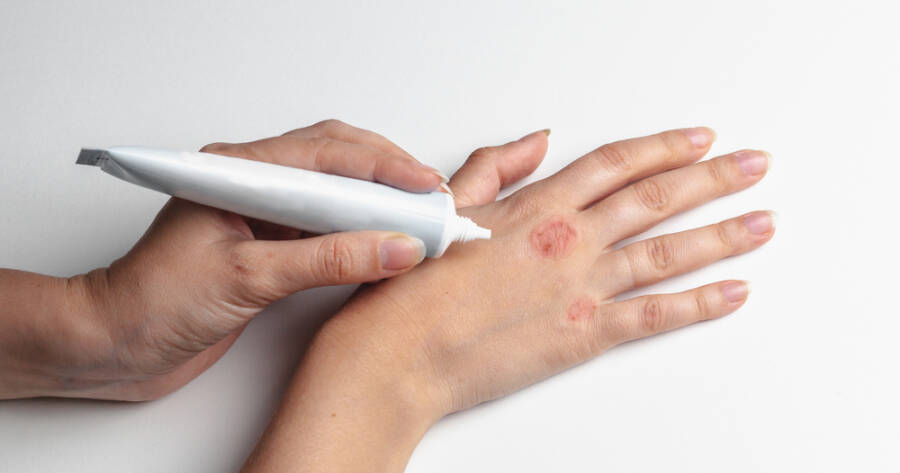Atopic dermatitis, commonly referred to as eczema, is a chronic inflammatory skin condition that affects millions globally, leading to persistent irritation, redness, dryness, and intense itching. Although most common in children, many adults continue to experience recurring flare-ups throughout life. While the precise cause remains unclear, a combination of genetic, environmental, and immune factors is believed to play a role. Understanding its symptoms, triggers, and available treatments is essential for effective management and relief.
What Is Atopic Dermatitis?
Atopic dermatitis is a long-term (chronic) condition that makes the skin inflamed, dry, and itchy. It is often associated with other allergic conditions, such as asthma and hay fever, and is considered part of the atopic triad.
While anyone can develop atopic dermatitis, it’s most common in children and infants. In fact, many children outgrow the condition, but some may continue to experience symptoms into adulthood.
What Causes Atopic Dermatitis?
The exact cause of atopic dermatitis remains unknown, but researchers believe it’s the result of a combination of genetic and environmental factors. Here are the main contributors:
- Genetic factors: Atopic dermatitis often runs in families, meaning that individuals with a family history of eczema, asthma, or hay fever are more likely to develop the condition. Specific genetic mutations, especially those affecting the skin barrier, have been linked to an increased risk of eczema.
- Immune system dysfunction: Atopic dermatitis is an autoimmune condition, meaning the immune system mistakenly attacks healthy skin cells. This overreaction causes inflammation, leading to the characteristic redness and swelling of the skin.
- Environmental triggers: Environmental factors such as allergens (dust mites, pollen, pet dander) or irritants (harsh soaps, chemicals) can worsen symptoms. Extreme weather conditions like dry heat or cold temperatures can also trigger flare-ups. Additionally, stress, sweating, and infections may worsen the condition.
- Skin barrier dysfunction: In people with atopic dermatitis, the skin barrier is often weakened, making it easier for irritants, allergens, and bacteria to penetrate the skin and cause inflammation.
Symptoms of Atopic Dermatitis
The symptoms of atopic dermatitis can range from mild to severe and can vary depending on the individual. Common symptoms include:
- Itching: The intense itching is often the most bothersome symptom, leading to scratching that can further irritate the skin and cause inflammation.
- Red, dry, scaly patches: Affected areas of the skin become dry, flaky, and red, with rough patches that may be accompanied by cracks or bleeding.
- Inflamed skin: Areas of the skin may appear swollen and inflamed, especially during flare-ups.
- Thickened skin: Prolonged scratching can lead to thickened skin, a condition known as lichenification.
- Blisters: In some cases, small blisters or pustules may develop, leading to oozing and crusting over time.
Treatment Options for Atopic Dermatitis
While atopic dermatitis has no cure, there are several treatment options available to manage the condition and reduce flare-ups. Treatment focuses on controlling inflammation, alleviating itching, and restoring the skin barrier. Common treatments include:
Topical Corticosteroids
These are the most commonly used treatment for atopic dermatitis flare-ups. Corticosteroid creams or ointments help reduce inflammation and relieve itching. They are available in different strengths, with milder options used for sensitive areas and stronger options for more severe flare-ups.
Topical Calcineurin Inhibitors
Medications such as tacrolimus or pimecrolimus can help control inflammation and itching without the side effects of corticosteroids. They are often used in sensitive areas, like the face and eyelids.
Emollients and Moisturizers
Regular use of moisturizers is essential for managing atopic dermatitis. Emollients help lock in moisture and restore the skin’s protective barrier. Thick, fragrance-free creams or ointments are recommended to help prevent dryness.
Antihistamines
Oral antihistamines can help reduce itching, especially at night when itching may be worse. They can also help with managing allergic triggers that worsen eczema.
Biologic Therapies
Biologic drugs like CINBINQO and ZORYVE represent the latest advancements in treating moderate to severe eczema. These medications target specific aspects of the immune system involved in the inflammation process.
CINBINQO (Abrocitinib)
CINBINQO is a Janus kinase (JAK) inhibitor that works by targeting specific enzymes involved in the inflammatory process. It helps to reduce the immune response and inflammation in individuals with moderate to severe atopic dermatitis. CINBINQO has been shown to significantly reduce itching and improve skin appearance in clinical trials. It is an oral medication and is used when other treatments are not effective.
ZORYVE (Rotastat)
ZORYVE is a topical treatment that targets the inflammation responsible for eczema flare-ups. It is a selective phosphodiesterase 4 (PDE4) inhibitor that helps reduce inflammation in the skin. ZORYVE offers a convenient and effective topical option for people with moderate to severe eczema, helping to alleviate symptoms and provide relief from itching and irritation.
Effective Management of Atopic Dermatitis with Modern Treatments
Atopic dermatitis is a chronic skin condition that can significantly impact a person’s quality of life. While there is no cure, many effective treatments are available to manage the condition and provide relief from symptoms.
With the right combination of medication, lifestyle changes, and careful skin care, individuals with atopic dermatitis can lead comfortable and healthy lives. Working closely with a healthcare provider to create a personalized treatment plan is essential in managing this condition effectively.

